Latest News
February 1, 2005
By Simon Hart
Beginning in late 2005, car makers won’t be able to sell autos inEurope unless they pass new tests to show their front ends are saferfor pedestrians. In European Union (EU) countries nearly a fifth of alltraffic deaths are pedestrians—9,000 per year—and 80 percent of themoccur when the victim’s head hits the hood or windshield at an averagevehicle speed of 25 mph.And while improvements in design have led to fewer driverand passengerinjuries, pedestrian injuries and fatalities now account for about 30percent of the overall number in Europe. As a result, the new EU tests(Directive 2003/102/EC) will cover head and leg impacts involving thebumper, hood, windshield, and A-pillar. Japan will require the tests in2007, and the requirements will become more challenging in 2010, when afurther phase of requirements takes effect in Europe.
Though the US National Highway Safety Administration has saidpedestrian deaths account for 11 percent of all motor vehiclefatalities in the US, the European market remains important for USmanufacturers.
An Analysis Pickle
The regulations have major implications for the design of vehicles nowthat the hood and bumper must be designed to absorb the energy ofimpacts at relatively low loads. The pedestrian impact tests consist ofpropelling test devices representing adult and child heads and legparts into the fronts of stationary vehicles. Instrumentation reportsthe accelerations and loads during the impact.
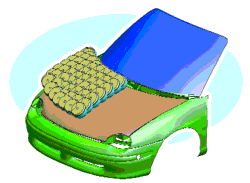
While modelling the tests for finite element analysis (FEA) takes asimilar approach to the analysis of a crash event, it stands incontrast to the crashworthiness requirements that have shaped vehiclestructures in recent decades. To perform well in crash tests, frontstructures must be stiff and deform at high loads to protect theoccupants inside. Additionally, the free space between exterior panelsand the interior components of a modern vehicle has been reducedthrough efficient packaging and styling trends.
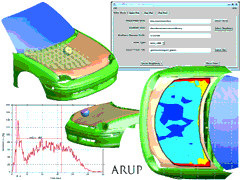
Arup Vehicle DesignGroup uses automated processes for model creation and post processingof results for pedestrian impact analysis. The multicolored hood showsimpact zones with contoured plot results.
Because of this, if the structure could deform at a low enough load, itwould not be able to deflect far enough to absorb the energy of apedestrian impact. Further complications arise from the need to haveexterior panels that are dent resistant, a hood closure of adequatestiffness, and a bumper system that can withstand low speed impacts.
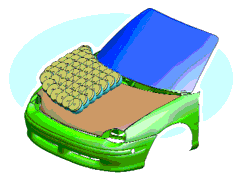
The headform model is positioned automatically for analysis of multiple impact locations.
As a result, the solution seems to be to allow for extra space betweensurfaces on top of what is necessary to fulfill traditionalrequirements. Bumpers will be deeper and softer and hoods will behigher with more space between them and the car’s engine and suspensiontowers.
The engineers responsible for analyzing vehicle structures are nowfaced with increasing numbers of analyses to perform. Because ofsimulations, extracting results, limited computing resources, andrepeated simulations due to modelling errors, engineers run the risk ofbeing sucked into a cycle of constant model updating and reanalysis.That means CAE becomes a burden.
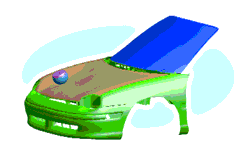
Front end model set up for a head impact analysis.
Saving Time in the ProcessBut some innovators in CAE have recognized this problem and ArupVehicle Design Group located in Birmingham, England, has developed anapproach that automates large portions of this analysis process. Thismeans engineers will be able to design new vehicle front ends to meetthe new regulations.Arup, using LS-DYNA—developed by Livermore Software TechnologyCorporation (LSTC) in Livermore, Calif.—as its finite element solverand Arup’s own Oasys Primer, D3PLOT, and T/HIS software packages forpostprocessing results, streamlined the usual approach to make it moreefficient. While many tasks in simulation are repetitive and timeconsuming, they nevertheless require careful control to avoid errors.Programmers recognized that automating these tasks—a few includepreparing different load cases, error checking, and extractingresults—would save time.
In the case of pedestrian protection, Arup Vehicle Design Groupdeveloped a process that lets engineers quickly assess the performanceof their designs. A computer program manages the analysis process andreduces the user input necessary for multiple model creation andexecution. It can automatically prepare and submit models for analysisand present key results to the user.
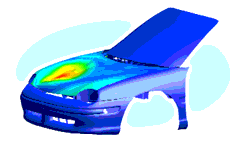
Contour plot showing displacement results for a head impact analysis.
Under the 2005 directive, two-thirds of the car’s hood must help limitpedestrian head injuries by reducing acceleration. This can beaccomplished by designing exterior car surfaces with more flexiblematerials and ensuring there is sufficient space below the surface toallow it to deform without contacting rigid components. To be sure ofcompliance, engineers must test every possible point of impact, leadingto hundreds of analyses for every hood design. Several designiterations are typical in auto design, so it is easy to see the benefitof a package that automates part of the process.
The vehicle model is specified on a graphical interface and the testdevice is chosen from a library. The user can submit a file of x, ycoordinates and the location of the impact point in 3D space will becalculated automatically. Input data is generated for every impactpoint and written to a subdirectory structure. Execution of the modelsis automatic. After analyses are completed, automatic postprocessingextracts critical data—in this case head injury criteria (HIC). Thisdata is presented as a colored plot of the impact zone, so that problemareas can be identified. The percentage area of the impact zone thatmeets the directive targets can also be calculated from this data.
Arup develops its own library of pedestrian test device models, whichcorrelate with the actual devices and test data from vehicle tests whenthey are available. The Arup program can also be used to manageanalysis of the upper and lower legform pedestrian tests.
Arup has used this process on vehicle programs with great success. Ithas allowed rapid response during the most critical stages of design,by bypassing the traditional bottlenecks in the analysis process. Arupis continually developing its range of analysis tools with the goal ofpushing CAE forward to meet the challenges of modern vehicle design.
Simon Hart joined Arup in 1994 and works in the Detroit Vehicle DesignGroup office, providing analysis and engineering services to automotiveOEMs and suppliers. To contact him about this article, send an e-mailmessage to [email protected].
Product Information
LS-Dyna
Livermore Software Technology Corp.
Livermore, CA
lstc.com
Arup Vehicle Design Group
Detroit, MIand Birmingham, UK
arup.com
Subscribe to our FREE magazine, FREE email newsletters or both!
Latest News
About the Author
DE’s editors contribute news and new product announcements to Digital Engineering.
Press releases may be sent to them via [email protected].






